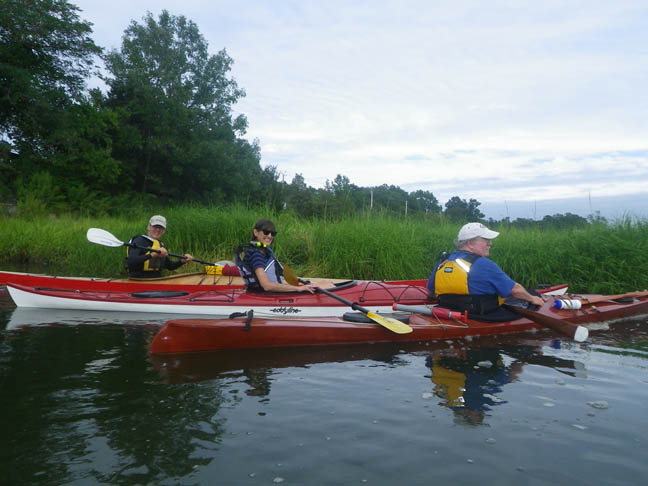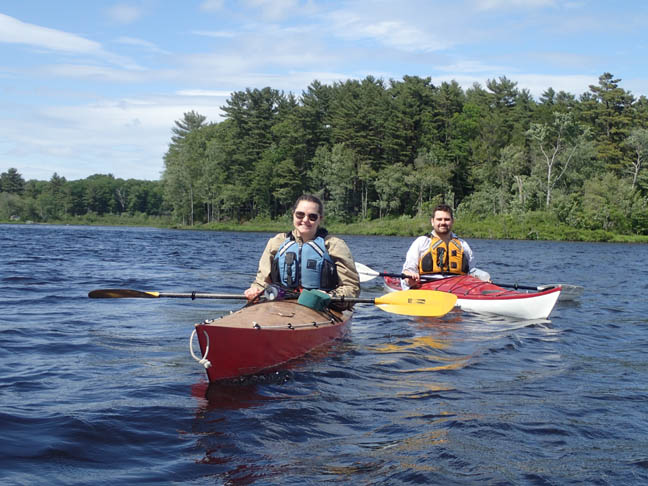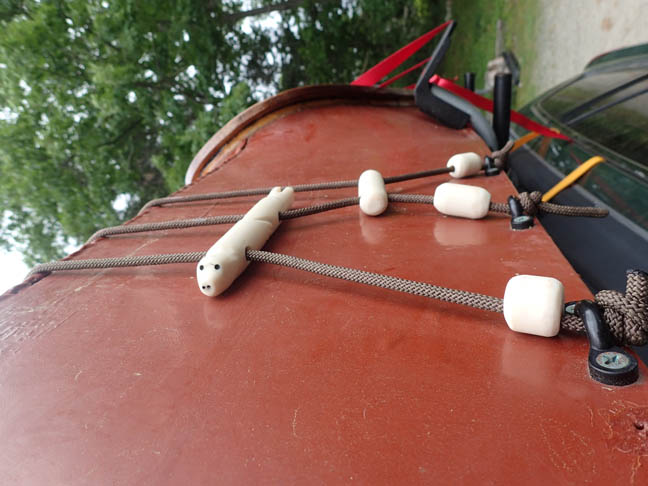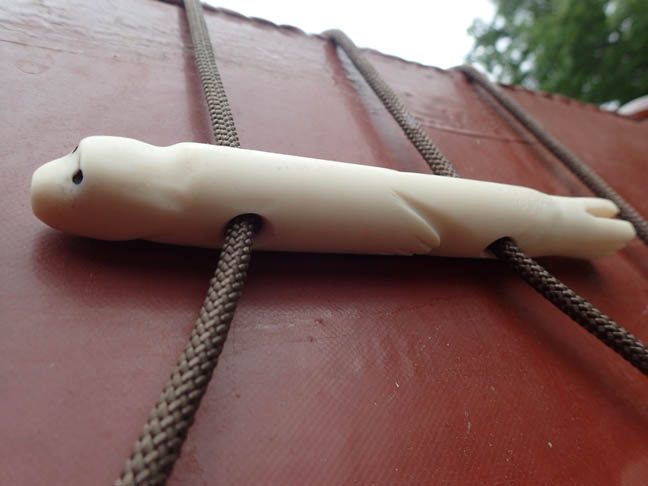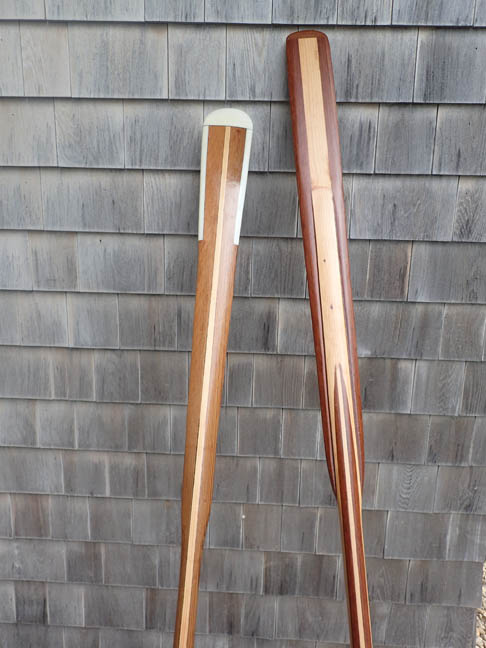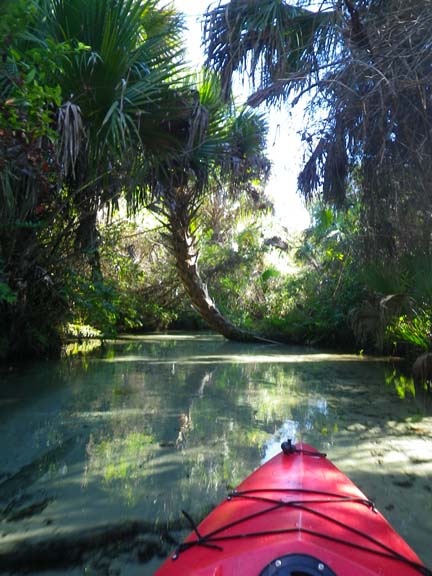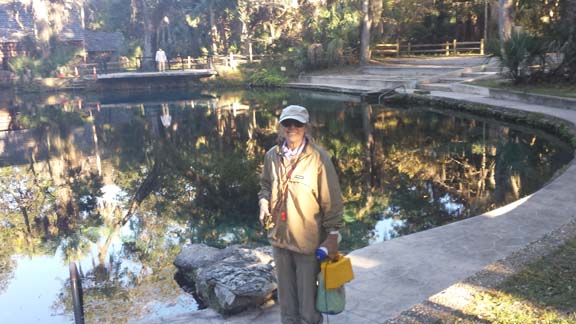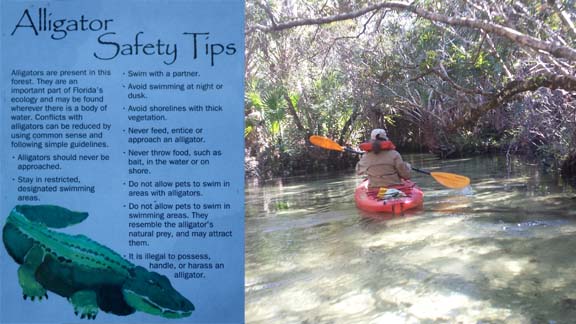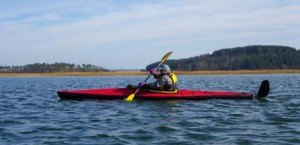 Dangriga, Belize Canadian ecotourism and adventure travel company Island Expeditions has announced its 30 Year Anniversary with promotional events going on for the next three months. The company has also confirmed its continued commitment to conservation efforts in Belize parks, each year contributing over $100,000 to organizations that are actively involved with protecting the coral reefs, wildlife management, education, and advocacy for sustainable development in Belize. Since 1987, Island Expeditions has been leading the way, introducing thousands of adventure travelers to Belize, educating them on the local Belizean culture in pristine environments. The activities the company offers include kayaking, snorkeling, stand-up paddleboarding (SUP), Mayan archaeology, and rainforest exploration.
Dangriga, Belize Canadian ecotourism and adventure travel company Island Expeditions has announced its 30 Year Anniversary with promotional events going on for the next three months. The company has also confirmed its continued commitment to conservation efforts in Belize parks, each year contributing over $100,000 to organizations that are actively involved with protecting the coral reefs, wildlife management, education, and advocacy for sustainable development in Belize. Since 1987, Island Expeditions has been leading the way, introducing thousands of adventure travelers to Belize, educating them on the local Belizean culture in pristine environments. The activities the company offers include kayaking, snorkeling, stand-up paddleboarding (SUP), Mayan archaeology, and rainforest exploration.
In 1987, Island Expeditions was one of the first adventure travel companies in the world to develop their unique brand of trips combining education and adventure on the longest barrier reef in the Western Hemisphere, even before UNESCO named it as a heritage site. The company is well known in Belize and has several remote island basecamps for reef activities: Tobacco Caye, Glover’s Reef Atoll (a United Nations’ World Heritage Site) and Lighthouse Atoll, which has close access to the legendary Blue Hole. Travelers can also experience a wide range of jungle adventure activities at Bocawina Rainforest Resort, a luxury rainforest resort with ziplines, cave tubing, bird watching, and Mayan ruins.
Island Expeditions founder Tim Boys states, “After three decades in Belize we’ve always known since the beginning how delicate and beautiful the Belize Barrier Reef system is and it’s been our mission to provide ongoing financial support while educating people from all over the world on how important this marine environment is to the global community.” Tim adds, “Island Expeditions’ trips are designed to provide the traveler with a complete Belize experience, no matter what time of the year they come.”
A pioneer in the adventure travel industry, Island Expeditions has been providing world-class kayaking, SUP, and snorkeling experiences in Belize for thousands of international travelers since 1987. Their Belizean guides are recognized as the top professionals in the industry – speaking multiple languages, they receive extensive training and are licensed by the Belize Tourism Board. Over the thirty years, the company has brought more than 22,000 tourists, including high school and university students to this Central American country. Students and travelers can get educated on the tropical marine life located in United Nations World Heritage Sites and jungle wildlife located in National Rainforest Parks. Island Expeditions is able to offer year round trips to Belize for all levels of travelers.
In April, Island Expeditions will continue to celebrate its 30-year milestone with discounts on trips booked to Belize, with new winners announced every week; and chances to win gear package giveaways, Amazon Kindle E-readers, and even a free lunch at popular restaurants like Olive Garden, Red Lobster, and the Keg Steakhouses.
To contact Island Expeditions:
US & Can: 1-800-667-1630
Int’l: +604-894-2312
UK: 0800-404-9535
www.islandexpeditions.com
Kids Just Wanna Have Fun at SeaSpray Kayaking
Image courtesy of Sea Spray Kayaking
By Tamsin Venn
Our current issue features some great tips and advice on what the camp counselors have to say about the fun kids have learning at kayak camp. We talked to Scott Shea, owner of SeaSpray Kayaking and Paddleboarding on the New Meadows River in midcoast, Maine. Shea is a long-term outdoors teacher and father of three sons so he’s in a good position to know.
“We’ve had kids who started in our kids camp when they were 11, now they are out of college, got their Maine Guide License, and are actually guiding for us… and they have full time jobs. It’s neat to see the interest sparked early and that it’s something that continues for personal and professional reasons,” says Shea.
Seaspray offers half-day and full-day camps for kids starting at age eight. It used to have half-day morning camps for just the younger kids, to keep their attention and to avoid the afternoon sea breezes that the older kids could handle better. But now Seaspray gives a choice of a half day or full day for everybody.
“That’s worked out. The kids know what they like, whether they want to be outdoors all day. The biggest thing we’ve found in teaching kids is that they learn by doing. The adults want to know precisely about what their body position should be, but the kids just kind of watch, and say ‘Hey I can do that,’ and then do it. Younger kids wonder how to do a roll. You just set them up and give them a feeling of what to do and they’re rolling. Adults don’t allow their brains to relax and feel it,” says Shea, psyched by his young students’ can-do attitude.
“With the kids, combining all kinds of challenges and games with the instruction works well. In wet exits, we tell them to hit the hull of the kayak before they release the spray skirt, they do it 51 times, so the next person has to get 52. We don’t have to say anything to keep them relaxed under water, it’s neat to see the kids push one another. They’re learning what they don’t even realize they’re learning. When we get into rescues, we treat it as a game. If they capsize, it’s fun to get the gear, get reoriented, and get paddling versus something that has to be really scary.”
Other activities include sailing with umbrellas or tarps, scavenger hunts, tugs of war, and fishing. SeaSpray offers week-long camps June through August at seven locations in Maine from West Bath to South Portland. It also has an advanced overnight camp and a fishing camp in Falmouth. Like the coast of Maine, every camp is a little different, Shea notes, with wide open ocean and surfing off Cape Elizabeth. Some areas are better for fishing, and some for whitewater. (Seaspray also sponsors a kids’ fishing tournament every year.)
Regarding the use of mobile devices, “The only break they get is snack time or lunch time, We don’t even have to say anything. We don’t have the downtime, so kids can’t go running over to use their devices,” says Shea.
Shea is highly experienced in outdoor teaching. Notably, he is the father of three sons, ages 12, 14, and 18. “They love the outdoors, so that’s always a nice thing,” he says of his three boys. He continues to take any outdoor ed class he can, and he’s gone through all the Maine Guide licenses in the state.
Age appropriate gear is essential. “The kids get free rentals for the rest of the summer, so they’ll bring their parents, and the parents are shocked on how well their children just take off. They didn’t think they could go that fast and that long. A lot of it is in the kayaks they are in. The number one thing parents should understand is the importance of equipment.”
For more information, visit the Sea Spray Kayaking website.
Kayaking Tips for Seniors by Tamsin Venn
A pod of oldies paddles the Ipswich marsh. Photo by Tamsin Venn.
Kayak touring is one of the best recreational activities for seniors. It is low impact. It’s easy to learn. It’s a great way to get together with other seniors and connect. It’s intellectually stimulating involving navigation skills and tide charts.
Here are ten tips to make this sport even more enjoyable.
- 1) Go light. Lifting a kayak on and off cars or the beach can strain your back. Light kayaks made of carbon fiberglass material can be well worth the investment. More kayak manufacturers, recognizing the need of the older paddler, are reducing weight using various materials. Aim for a boat 35 pounds or less. Consider a wood kayak, which is light, durable, lively, and lovely to look at.
- 2) Invest in a good paddle for ease of swing weight. Again carbon light materials can be expensive but well worth the price, and wood is a good option. Consider a Greenland paddle. It has a longer and narrower blade that lessens the upload on your arms and shoulders.
- 3) Lifting your kayak on and off a car, especially as a solo paddler, can be onerous. Thule makes something called a Hullavator, a mobile rack that allows you to load the kayak at waist level on the side of the car, then lifts it onto a rack on top of the car. A strut device eases most of the kayak’s weight.
- 4) Most kayak accidents happen on land, on rocky shores where you may slip on seaweed. Always step in between the rocks, not on top of them.
- 5) A kayak cart removes the need to haul it on your shoulders. You can even rig up a cart to a bike to get your boat to the water. If you ever go to the Adirondacks, where portaging from one pond to another is de rigeur, you will see seniors everywhere using kayak carts. Strap them to the back of your kayak when not in use, or stow them in the rear hatch. Nothing says portage better than kayak cart.
- 6) The usual kayak safety planning is even more important as you get older. File a float plan with a family member or friend. That indicates your proposed route, time of return, and a description of your kayak. Other useful (and in some cases mandatory) items: a weather radio to indicate wind force and direction; cell phone in waterproof case or VHF; a pfd (personal flotation device); whistle; and a wetsuit or drysuit if you are paddling in cold water. Hypothermia from cold water immersion is one of the kayaker’s biggest challenges.
- 7) Carry a tow rope, so you can tow the grandkids in their kayaks back to shore if they get tired, or so they can tow you! Towing is a remarkably easy way to assist someone back to shore.
- 8) In the off season, lift light weights to keep shoulders and arms strong.
- 9) Do yoga to assist in balance and flexibility, especially key for getting in and out of your kayak.
- 10) As in downhill skiing, road biking, or other low-impact sports where you might run into crowds of people or vehicles, it’s best to venture out when you can expect less traffic. Avoid busy summer weekends when motorboat and Jet Ski traffic is at its most frantic… and noisy. Go early in the morning, when the world is tranquil, and you’ve got the water to yourself.
Happy Summer Paddling!
Tamsin Venn is the publisher of Atlantic Coastal Kayaker and a regular contributor to Seniorsskiing.com
Tamsin Venn Reviews the 2016 MITA Guide
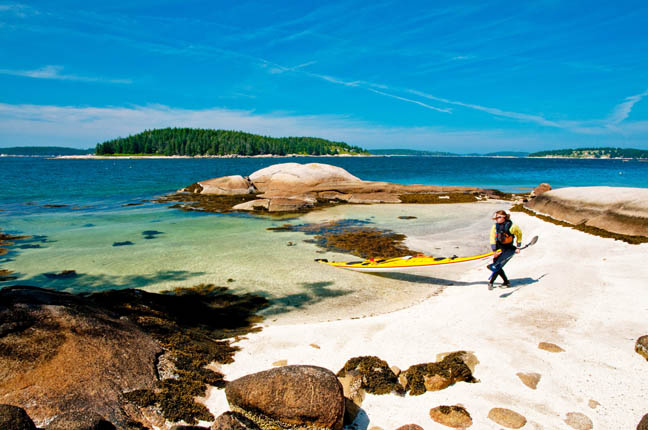
You know summer has arrived when the MITA (Maine Island Trail Assn.) guidebook arrives in the mail. Or the link to the new mobile app in iTunes for the online version. Now we can get down to some serious paddling adventure planning in Maine this summer.
The guidebook always sends me into flights of fancy. Will this be the summer I paddle the entire trail, from Kittery Point to Machias? With family obligations lessening their pull, why not?
The other approach, though, as I read through most of 280 pages or so of the 6×8 spiral notebook is the idea of sampling. Let’s see, I could launch from Round Pond and visit Thief in Muscongus Bay or launch from Tenants Harbor and visit Cylends; or set out from Millbridge Town Landing to land on the bold and beautiful Bois Bubert. I am always ready to go back to Deer Isle, stay at Old Quarry, and do the Merchant Row circuit; then Jonesport Campground and paddle to the exquisite Little Water island. Just drive up for the weekend and putter around for a couple of days.
It is all eminently doable thanks to the MITA guidebook, which has now been published for 28 years. Like a sturdy oak tree, it has aged well. It still uses a lot of the original material – about 40 pages of the essentials like what to carry for safety measures, wildlife protection and viewing, camping regulations, leave no trace, what to do with waste and trash, afternoon winds and weather, and how to tie a knot or two. All of it is incredibly useful information, admonitions interspersed with basic know how.
Then come descriptions of the islands themselves, running south to north, now ending in the Canadian Maritimes. Having received this book every year for more than two decades, I flipped through, savoring many memorable visits of the place and people I was with.
The tenor has altered, from the mix of public BPL (Bureau of Parks & Lands) and privately owned islands, once nearly 50/50 split as I recall. MITA was a marriage of state and private owners who embraced and respected the spirit of mariners using their islands in the public interest. Over the years, a new cast of players has joined the ranks. Fifty concerns – land trusts, friends of, towns, a science center, a college, Audubon, Chewonki, and even the Cuckolds Fog Signal & Light Station Council, have joined the ranks, publicizing use, mostly day use only, but necessary jewels in the crown for safe navigation along the coast. It is a remarkable consortium of island owners, all joined in the spirit of providing public access. They only ask one thing, that the paddler follow the usage guidelines and restrictions, listed on the site description pages in the guidebook.
I would venture that the idea of the trail as an Appalachian Trail on water – the holy grail of paddling the full 375 miles, from Portsmouth to Cobscook Bay, spending a summer to do so, using the 200 islands and mainland sites as stepping stones – is still alive and well.
I found myself checking out, with increased interest, the islands of one acre or less which the guidebook notes would accommodate only two people; like the tiny house movement, maybe the tiny island movement will take off.
Also, I aim to use the app which is loaded with very useful information, including photos of the islands so you can get an idea of what the island looks like and land on the right one.
Summer is not summer without a trip to a Maine island. For the price of membership in MITA, you have all the information you need to make that happen. Go to MITA’s website for more.
See you on a Maine island!
Photos are copyright by Daniel E. Smith / ScenicNewEngland.net and courtesy of the Maine Island Trail Assc.
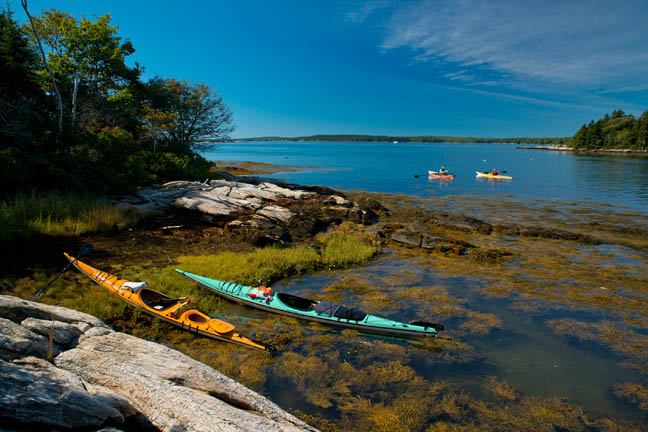
Paddling Pater on Dies Patris
So, we were actually a week off. I’m going to try to see if I can winkle another breakfast-in-bed on the actual date. As part of my wishes for Father’s Day, I wanted to go on a family paddle. 18-year-old Anton was unmoved by filial loyalty and buzzed off with his friends, but I managed to get Tammy, daughter Lilly, and her friend Dan out. Unfortunately, although the day was quite lovely, there were extremely high winds (17-45 mph) and small craft advisories, so we decided to go to the closest large lake around, Chebacco in Essex. (And, yes, if you google Lake Chewbacca, you will find a link to it, as well as to that crazy (like a fox!) Chewbacca Mom on youtube.)
We got to the lake just as a large contingent of gleaming, sparkly bass boats were leaving. The lake is small enough (~240 acres) that boats are supposed to all travel counter-clockwise. Since we mostly had the lake to ourselves, and since we hugged the windward shore, as much as one exists on a small lake, we paddled where we chose and encountered nothing worse than winds strong enough to tear my sun hat off. A short paddle, and not one I would choose except in similar conditions, but pleasant enough. I suspect that if the winds had not been so fierce, we would have found the lake covered with boats on a beautiful Sunday. Tammy took the pics with the neat camera I gave her on Mother’s Day 2015, which is why no pics of her, but I think the one of her and Hog Island at the top of the blog makes up for that.
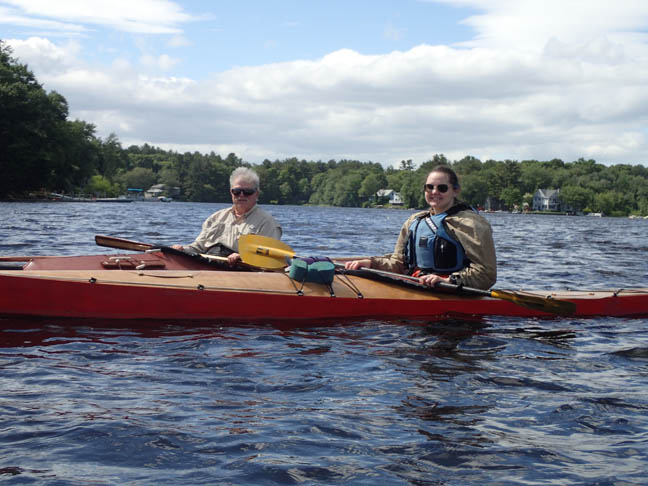
Some accessories for Puisinniaq
Recently got Skinboats of Greenland (Ships and Boats of the North) by Greenlander HC Pedersen and decided to make some accessories. I built two more skinny sticks. I used some scrap Corian I bought on eBay to make “whale bone” tips and edges on one, and ipe scraps for the hard edges on the other. I also got hold of some faux ivory, removed the deck bungees and added carved tighteners and spacers, and then crafted a practice harpoon and made a faux ivory point in case I meet any styrofoam seals on the water.
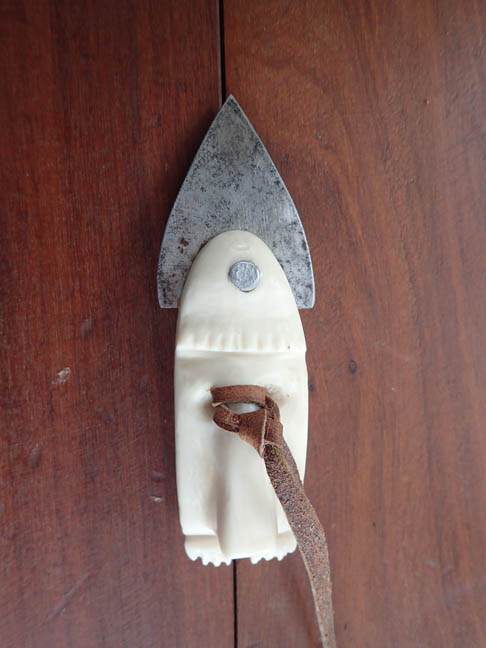
Launch of the Puisinniaq
“Seal Seeker” was christened and launched for sea trials yesterday in Plum Island Sound off Pavilion Beach in Ipswich. Seal Seeker is an 18-foot KudzuCraft skin-on-frame design, the Long Shot, with a few modifications:
1) More extreme bow overhang.
2) Bow and stern Valley Canoe-style rubber hatches.
3) Grab lines along gunwales.
4) Padded seat.
Editor David Eden: I used 10-oz ballistic nylon and two-part polyurethane colored with rusty earth pigment to simulate seal skin. That and the hatches added to the final weight. I couldn’t get the cockpit rim to screw together from underneath as directed, so I ran 1 1/4-inch silicon bronze screws in from above. The screws to hold down the hatches are also silicon bronze, and the staples to pull the skin taut around the openings are rust-proof Monel. Tammy, who paddles an old Necky Arluk 1,8. said that she thought the Long Shot was a terrific design and paddled more easily than many of the boats she has sampled! Her only complaint was that her hands rubbed on the cockpit rim. I said that the Long Shot was designed for heavier people like me, but that KudzuCraft had a smaller version for lighter people, the Short Shot. Maybe the next build…?
The really depressing thing is that I am SMILING in all the pictures. No wonder everyone thinks I am a grouch!
In some of the photos, you can see my “whalebone” rub keel, made from a nylon carving board. There is one in the stern, as well.
The finished frame. So pretty, I hate to skin it.
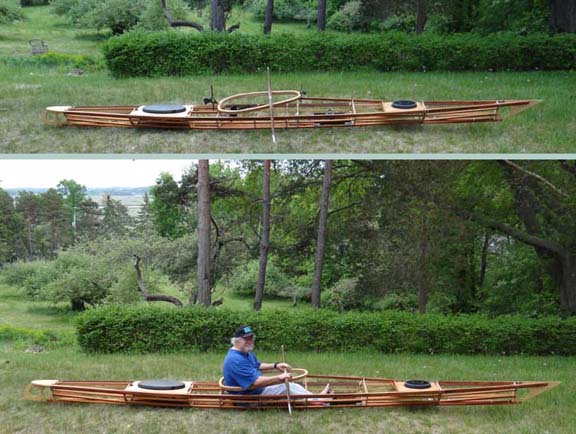
Hauling out of the “workshop,” our screen porch.
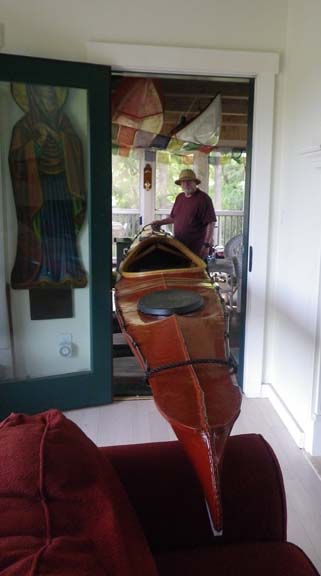
An old paddling friend, Peter Moore, who came down with his wife, Alicia, to share the fun!
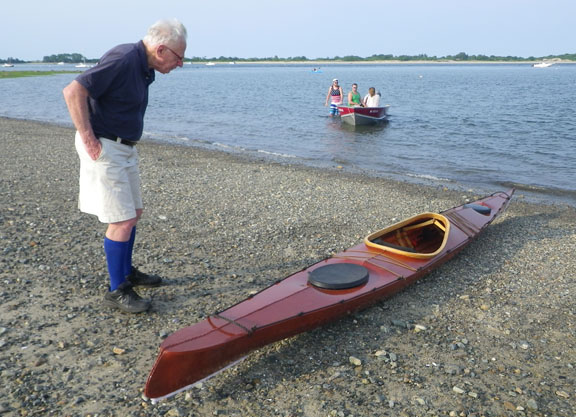
“I christen thee Seal Seeker.” Have to get that translated to Greenlandic…
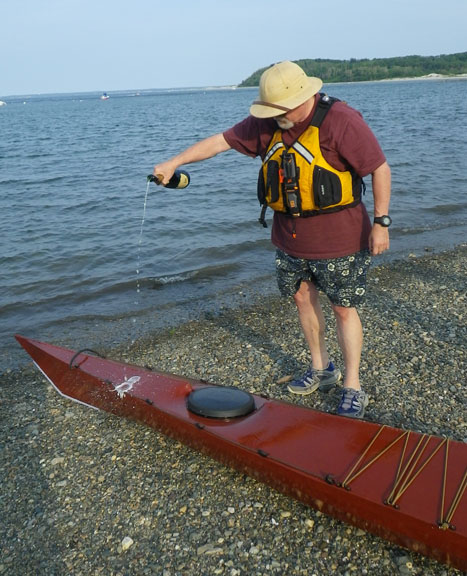
Tammy and I and Peter and Alicia share some bubbly.
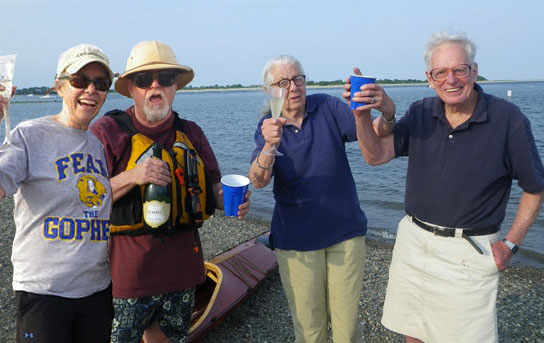
Off I go. Although you can’t tell from the photo, there is some nasty stuff, little boils and refracting waves off the point to the right background, where the Ipswich River meets the incoming tide, which is pushing through at this point at about three knots.
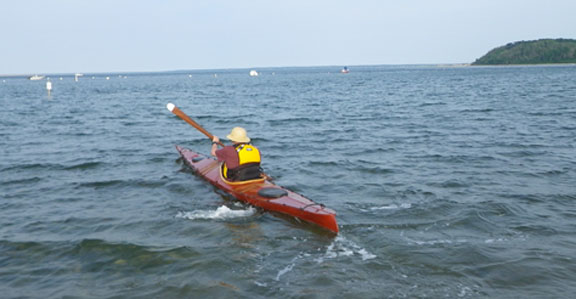
First run. Stable, dry, tracks like a train, steers like a cow. I was hesitant to lean hard without a sprayskirt, but the boat is hard to turn It may be the bow and stern rubrails. which accentuate the keel. Tomorrow, I will wear the skirt and lay Seal Seeker right down on her cheeks. There is a line of sandbars almost straight ahead of me. 22 years ago, while waiting for a date with the lady whom I was to marry, i was surfing off them in a fog one October morning. I glanced to my right, and there was a seal surfing the clear wave right next to me! Never before or since – we were the only living beings on the water that day, And so – Seal Seeker. (Update – I found a website that will translate English to Greenlandic. The very nice site owner, Nuka Møller, translated Seal Seeker as Puisinniaq.)
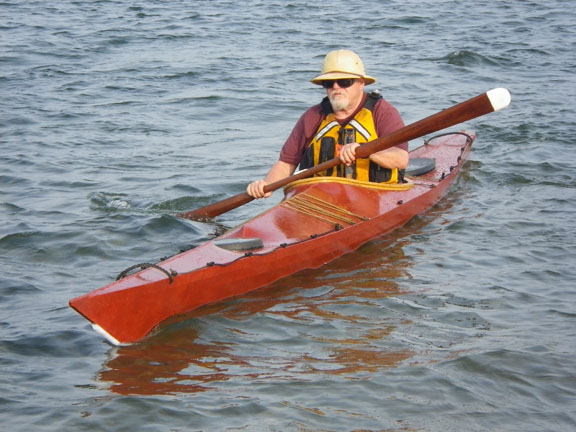
.
Juniper Run, Florida
We flew down to Florida early December on a jaunt to use a Jan. 1 deadline timeshare. We ended up in Palm Coast, which lies between Jacksonville and Daytona Beach and just south of St. Augustine, on the Atlantic side. The Matanzas River ran outside our front door, and the beach was a toll-pay over the bridge.
It is an area of Florida with which we were unfamiliar. We have paddled in the Everglades, Miami, and Sanibel. We have run several articles on the Keys. We have reported on WaterTribe’s Ultimate Florida Challenge (race around the state) but never covered this area.
It was not looking productive. None of the many Florida kayak guidebooks written over the past 20 years, had much on this area, except for St. Augustine. To the south the Canaveral Seashore is known, and to the north, Cumberland Island, Georgia, but not much in between. So we went to our Florida source: Kayak guru Ken Fink, who retired to the Tampa area several years ago with his wife, Joan. They still return to Maine in summer.
Ken responded immediately, and spoke of how they prefer to paddle the fresh water flows and springs in Florida (less crowded) and the ocean in Maine. He gave us several suggestions and particularly recommended Juniper Springs run. It turned out it was only an hour from Palm Coast, so Juniper Springs it was.
We crossed from the coast west to Juniper Springs in the Ocala National Forest, about an hour’s drive. Juniper is one of four notable springs in this area, the others being Alexander, Salt, and Silver Glen. (Silver Glen Springs was featured in the first chapter of Marjorie Kinnan Rawlings’ classic youth novel, The Yearling, published in 1938.)
Juniper Springs is unique in that the National Park Service has a canoe/kayak concessions for a seven-mile run down Juniper Creek to see up close the Juniper Prairie Wilderness Area. They pick you up at the end on an hourly schedule.
The combined daily water flow from Juniper and Fern Hammock Springs is about 13 million gallons, which assures a swift push down the creek.
Jupiter Springs is a gorgeous place and historic. It was a Civilian Conservation Corps project in the 1930s, whose gratefully employed workers under FDR built a lovely mill wheel and house, a concrete amphitheater surrounding the spring. It has a campground, .75-mile barrier-free interpretive nature trail, and camp store.
You are supposed to get on the water by noon, and they say it takes three to four hours to make the run. It took us exactly three and we probably could have done it in less, if it weren’t for back issues with the sitontop.
The springs formed millions of years ago. A shallow sea that once covered much of Florida formed layers of limestone from compressed coral reefs and shells in the ancient sea. Acidic rain seeped into the limestone and formed caves and underground channels. The limestone bedrock that collapsed formed the springs. This natural geological system, called Karst Topography, includes interesting features like warm springs and aquifers.
The water temperature is a constant 72 degrees year-round, and the springs pour millions of gallons of water from the aquifer daily. You can see where the water boils up out of the aquifers, like a water hurricane.
It is common for animals such as turtles, alligators, snakes, raccoons, eagles, ospreys, herons and egrets to hang out in these areas. In the jungle, but seldom seen in the day, are bobcats, coyotes, grey foxes, and possibly even the nearly extinct Florida panther. Alas, we saw several turtles but no alligators. They must have been withdrawn into their winter hiding holes because of the chilly weather. In fact, we saw little wildlife other than a fawn disappearing into the woods, a great blue heron, several red-bellied cooters (a type of freshwater turtle), as large as small platters, sunning on partially submerged logs, some zebra longwing and viceroy butterflies, a few bluegills and a large school of what looked like freshwater American shad, which are certainly found in the nearby St. Johns River. (Freshwater fishing in this part of Florida is fabulous, by the way, and is certainly worth looking into if you are in the area with more time time than we had.)
The current pushed us along swiftly, and I loved ducking down to avoid overhanging limbs. NPS had neatly sawed off most of them for a non-obstructed run for this very popular tourist attraction. Most people have a float trip mentality, and you do actually have to pay attention to get around some limbs, logs, and haul yourself out of the brush on the side.
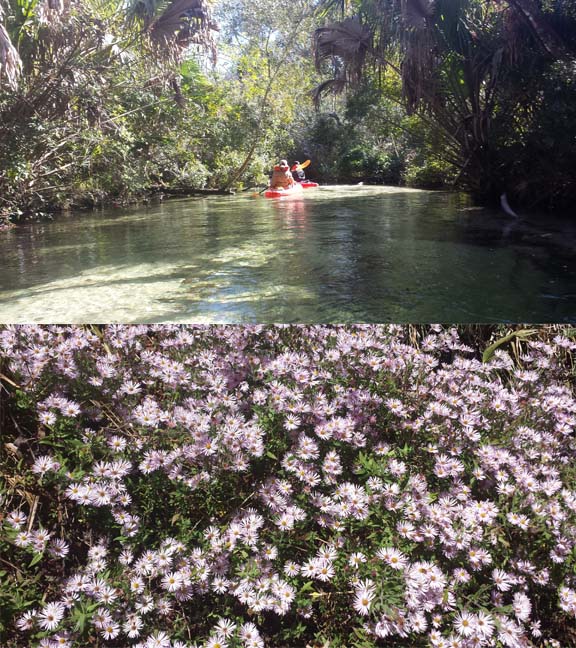
T. It looks serene, but the current could be fast and the obstacles many. B. The only flowers blooming at this late season were these unidentified asters.
Early December, there were only about five parties out on the river, but in high season 35-50 parties haul down the creek. It must be kind of crazy on the water, although you know you won’t get any drunk yahoos because of bag checks at the start.
The collision of National Park Service concession mentality and wilderness experience aside, Juniper Springs is an absolute marvel and a wonderful antidote to New England winter.
In summary, if you find yourself in mid Florida on either coast, we highly recommend a jaunt inland to Juniper Springs.
Late Fall Paddle
November: an absolutely beautiful late fall paddle, unusually warm. It also happened to be Veterans’ Day, so we had our own parade. We took the Long Haul folding kayak that Mark Eckhart recently shipped us from Colorado to try for a spin out around our usual promenade. Out the Hay Canal and toward Hog Island.
We wore shorts and long sleeved shirts and neoprene socks, our only concession to the not-at-all cold water paddle for this late in the season.
The Mark 1 is more used to seeing the icebergs of Greenland or the whales of Baja. It has been to some of the wildest places on nearly every continent. Here it only had to cruise through the marshes. But what a pleasure it was. The workmanship is really fine, and it’s nice to be in a canvas and wood cocoon. As Mark says, he’s a wood guy, and is a firm believer that you have a much better chance of putting a wood frame boat back together in the wilderness.
The cockpit is small, ideal for keeping out breaking waves, and high, but your elbows reached below at just the right height. The rudder was a gem, so easy to manage. The boat itself glided along splendidly, just itching to get some serious miles under it.
It was an appropriate boat for Veterans’ Day. Mark makes a double version for the U.S. Special Forces, the Mark II Commando.
The afternoon colors were amazing: gold, yellow, orange. Wildlife seen: two great blue herons still hanging out, a short V of Canada geese, ducks (unIDed) flapping skyward when approached by kayak, the usual comorants, and a raft of 30 skittish buffleheads. Clearly migration is still on. Only one other boater: a fellow in a rowing shell that made quick work of the Hog Island circumnavigation. The paddlers and rowers once again united in owning the waters.
The Lakes of October
Squam. Chesuncook. Moosehead. Newfound. Winnipesaukee. Sunapee. Champlain. George. Saranac. Lows. Bog. Those are the evocative names of lakes we’ve covered in our annual “Lakes of October” issue.
Initially, it was a novel concept for sea kayakers to paddle on lakes, but bright foliage, distant mountains, and tamer water conditions in the off season were the draw.
One set of interconnecting lakes we cover for the first time in this October issue. I became familiar with them last year when looking up the details on a race called the Endurance Challenge, which includes kayaking across two lakes, mountain biking, and mountain running, over hundred of miles of wilderness up and down. The race takes place in the Connecticut Lakes, high in northern New Hampshire on the Quebec border. The Fourth Connecticut Lake is the origin of the 410-mile Connecticut River. You can take a steep up and down climb, past Canadian customs, to see this tiny beaver pond where the longest river in New England starts.
We highly recommend this semi-wilderness kingdom high up in New England, well known to fishermen for the brookies and rainbow trout and to birders for the migrations, but less well known to kayakers. We researched the lakes in August when everything was still green, but it should be gorgeous up there now…


